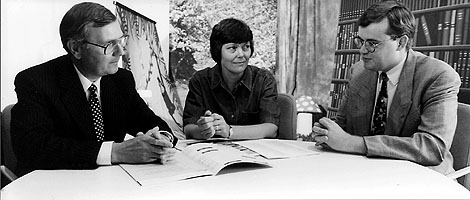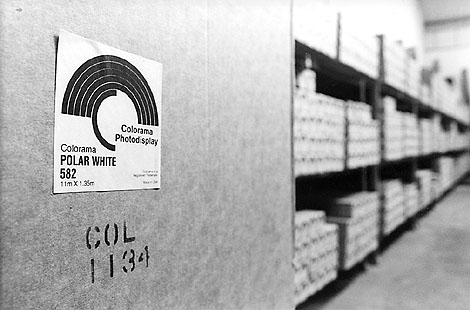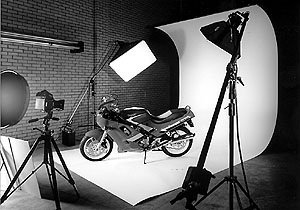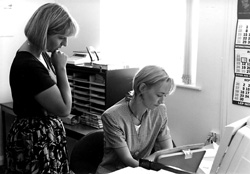
Alec and Sue Harris discuss marketing strategies with John Woodhead

The amazing success story began in 1957, when paper-maker Wiggins Teape unveiled a new range of products aimed at the photographer. Those Colorama rolls were Europe's first background papers. Despite growing to become a very successful line, paper backgrounds remained small fry by the overall standards of the company. The sixties, seventies and eighties saw the brand grow to become the generic name in the UK. In 1984 the company introduced Rainbow graduated backgrounds which also grew to become a well established product amongst commercial photographers.

Alec and Sue Harris discuss marketing strategies with John Woodhead
In 1989, a management buy-out saw the marketing and distribution rights pass to an independent company - Colorama Photodisplay, founded by Alec and Sue Harris. "Colorama had a strong brand name, but there was room for marketing expansion", explains Alec. "Wiggins Teape wanted the name to continue, but they didn't want to do it themselves". Recognising there were other companies that marketed backgrounds as part of a larger portfolio of unrelated products, Alec and Sue set about building a range of backgrounds that was unique and totally complete.
This far-sighted vision lead to a string of additions and, in 1991, an exclusive deal with Denny Manufacturing - the largest producer of fabric and canvas backgrounds in America. As part of that arrangement, Colorama Photodisplay became Denny's exclusive distributor in Europe and Scandinavia. "Prior to 1991", Alec recalls, "we were serving mostly commercial photographers, but the fabrics took us into the portrait market" .
A year later, the company announced new products for both sectors. Commercial photographers were offered Colorcove (an inexpensive coving system), while social photographers had Denny's new Colormaster canvas range. Further fabrics and canvases were added just twelve months later, and in the same year the company broadened its product range by launching its own studio and portable background support systems. Until that time, Manfrotto had the field almost completely to itself, but Alec and Sue didn't regard their versions as direct competitors. They were, in Alec's words, "different types of products." This has always been, and continues to be, a crucial part of the Colorama Photodisplay philosophy: "we aren't a me-too company", he adds.
One of the biggest differences between Colorama and other companies is the firm decision not to supply products direct to end users. The theory - and indeed the practice too - is that this gives a much better level of service because photographers are able to deal with local retailers in person, rather than an anonymous voice at the end of a telephone line. This said, Colorama has listened to dealers' desires to reduce stock levels and has, on their behalf, introduced next-day deliveries direct to customers.

Colorama's own 13,000 square foot warehouse, located just outside Birmingham, holds �1/3m of stock comprising approximately 20,000 items. Alec observes that "our competitors have tended to reduce their background paper ranges over the years - ours is the biggest in the UK. Our full range is available in half rolls as well. We try not to change the range too frequently because people get to know the colours, but every five years or so we do modify things to keep up with current trends".
In paper rolls, for example, Chromablue and Chromagreen have recently replaced similar shades. The new versions are as close as possible, within paper-making limitations, to Chromakey blue and green, and were introduced following repeated requests from video and TV users. Another new colour, Royal Purple, came about as a suggestion from the paper mill. "It was a colour that the manufacturer wanted to make even though we weren't sure. But it's sold surprisingly well". Listening to other people, especially users, does have its problems though. "If we listened to the market, we would make the mini-cove in thirty different sizes. But we do respond to new ideas when we can. We're about to launch a new 3.55m width background roll in a new grey. It's been particularly requested by the auction houses" .
Colorama is equally keen to reply to feedback with information and ideas that photographers can use to improve their businesses. On one level, this can be a matter just of suggesting that portraits could sometimes be taken against backgrounds other than the traditional graduated brown splatter pattern. "We want to encourage people to explore new backgrounds, but we do have to respect what photographers say they want - and often they blame their clients".
Even so, it is still a pity that so many portraits look so much the same. "If people want backgrounds that are made by Denny but aren't normally stocked by Colorama, we can do special orders. We can bring in products that wouldn't be economically viable for individuals". It's a generous offer, and one that certainly deserves to be taken-up when the time is right.

Colorama's low-cost Colorcove system brings the advantages of coving within reach of many more professional photographers.
On another level, Colorama is well aware that its low-cost Colorcove system can bring certain difficulties of its own. In particular, photographers who previously believed they couldn't afford a cove are now able to install one after all. But they don't always know how to get the best results. Apparently, a lot of people don't realise that Colorcoves, and mini-coves too, should be painted before use. In their raw state, hot spot reflections can occur: painting with white matt emulsion solves any such problems. Of course, coves don't have to be white. In fact, they can be painted any colour at all, and can be returned to white again afterwards.

Chris Owen and Karen Mahon in the Colorama sales office
Since its inception, Colorama's turnover has increased by 70% and its staff has grown from six to nine with five of the original employees, all formerly with Wiggins Teape, still working at the company. Distribution extends across Europe and out to Pacific Rim markets in a network that now consists of about forty overseas agents.
Clearly, Colorama Photodis-play has been a massive success story to date, but what of the future? "We're moving away from offering scene a, b or c. We're tending to say you can have your own customised background". Photographers who've brought such items have said, according to Alec, that they're a real money-spinner. He singles out the Playtime Photosets, which journalist and photographer Rod Ashford once described as "photographs waiting to happen".
"This last year has been a very interesting one, because for the first time we've been able to sit back and look at our whole range in detail". Gazing into his crystal ball, Alec predicts that "in the years ahead we will look outside backgrounds, but whatever new product diversification we get involved with will be one that suits our business. There have been new products in the last seven years, and as new opportunities present themselves in the future, we'll certainly go for them".
Whatever happens, Colorama's roots remain firmly planted in background soil. "We've tended to invest a lot of time, effort and money in promoting the uses of backgrounds, especially in the portrait market. It's sometimes difficult to get the message through that backgrounds are important". Ah yes, but Alec would say that wouldn't he! The point is, he's absolutely right.
Return to Photon September 96 contents